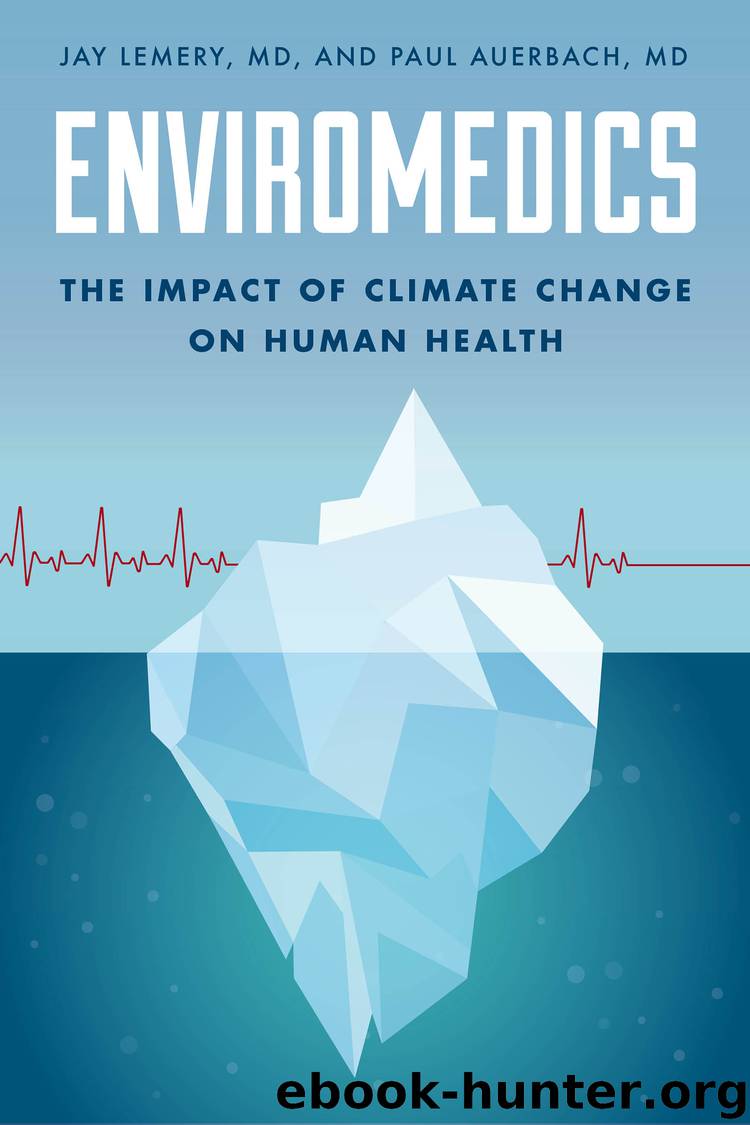Enviromedics by Jay Lemery & Paul Auerbach

Author:Jay Lemery & Paul Auerbach [Lemery, Jay & Auerbach, Paul]
Language: eng
Format: epub
Publisher: Rowman & Littlefield Publishers
Published: 2017-08-01T04:00:00+00:00
Mold
Mold makes up the other half of the dynamic duo (with pollen) of environmental allergens. The kingdom Fungi entails life forms distinctly different from plants and bacteria, and includes mushrooms, molds, yeasts, rusts, puffballs, truffles, morels, and smuts. They tend to grow in moist, warm, and often shady areas but are found nearly everywhere, including indoor environments, such as shower stalls or areas that have water leakage. The reproductive units of fungi are called spores. Like pollen grains, spores are very small, abundant, and highly allergenic. Inhalation is the most common type of exposure to mold. Because many airborne fungal spores are tiny, they are inhaled into the deepest parts of the airway and lungs. Allergic reactions to mold spores are typified by symptoms similar to those associated with pollen allergies: eye irritation (conjunctivitis), runny and itching nose with nasal congestion (allergic rhinitis), inflammation within the sinuses (sinusitis), and asthma.
Where humidity and precipitation are found, particularly in combination, so is mold. Warming environmental temperatures, along with increased carbon dioxide and extreme weather events, will be considerable drivers for proliferation of allergenic molds. The impacts on human health can be substantial. Molds are diversely effective pathogens; they not only cause allergies but can also undermine human health in nonallergenic ways. In damp conditions, mold can rot grain stores rapidly, which effectively destroys tremendous amounts of grains, such as wheat, corn, and barley. This undermines food security in a devastating manner. Major risks for mold exposure arise during periods of sustained humidity and in flood or post-hurricane/typhoon/monsoon environments. Massive water deposition into residential areas by heavy rains and standing pools of water can lead to dangerous mold levels, particularly when homes have had water damage. Sediment deposition in flooded spaces that retain water and moisture creates a protected, wet environment that is a haven for fungal growth, which translates into a toxic milieu for humans. The threat to a person’s lungs is greatest during cleanup or repairs, when mold deposits are disturbed and then can easily enter the air we breathe and, therefore, invade the smallest airways within our lungs.
Most recent data on mold exposure attributed to an extreme weather event come from New Orleans in the aftermath of Hurricane Katrina. A significant percentage of city buildings were underwater for weeks, resulting in a proliferation of mold. According to the Centers for Disease Control, nearly half of the homes in the New Orleans area showed visible mold growth, 17 percent had heavy mold coverage, and allergy-causing molds were found in both indoor and outdoor environments.14 Outdoor spore counts remained abnormally high for months after the hurricane, with higher counts recorded from persistent mold growth inside flood-damaged homes. The medical clinical aftermath was profound. Local hospitals reported increased numbers of patients complaining of allergies and cold symptoms. A spike in complaints of chronic cough associated with difficulty breathing was nicknamed “Katrina cough” or “shelter cough.”15 The overall rate of childhood asthma increased in the New Orleans area after Hurricane Katrina.16
Predictions are that because
Download
This site does not store any files on its server. We only index and link to content provided by other sites. Please contact the content providers to delete copyright contents if any and email us, we'll remove relevant links or contents immediately.
Inner Engineering: A Yogi's Guide to Joy by Sadhguru(6728)
The Power of Now: A Guide to Spiritual Enlightenment by Eckhart Tolle(5610)
Fear by Osho(4662)
Ikigai by Héctor García & Francesc Miralles(4125)
The Art of Happiness by The Dalai Lama(4063)
The Ultimate Bodybuilding Cookbook by Kendall Lou Schmidt(3886)
Yoga Therapy by Mark Stephens(3704)
The Little Book of Hygge by Meik Wiking(3647)
The Healing Self by Deepak Chopra(3476)
Why Buddhism is True by Robert Wright(3405)
The Hatha Yoga Pradipika (Translated) by Svatmarama(3234)
Being Aware of Being Aware by Rupert Spira(3230)
Shift into Freedom by Loch Kelly(3134)
Wild Words from Wild Women by Stephens Autumn(3095)
Work Clean by Dan Charnas(3055)
Happiness by Matthieu Ricard(2993)
More Language of Letting Go: 366 New Daily Meditations by Melody Beattie(2969)
Yoga Body & Mind Handbook by Jasmine Tarkeshi(2835)
Why I Am Not a Feminist by Jessa Crispin(2697)
